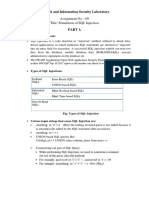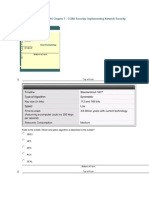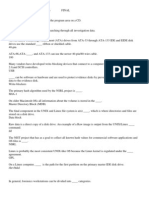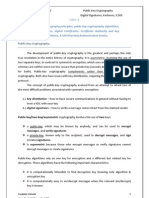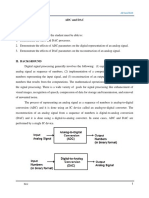Message Authentication and Hash Functions
Uploaded by
MukeshMessage Authentication and Hash Functions
Uploaded by
Mukesh4/10/2011
Authentication Requirements
Kind of attacks (threats) in the context of communications across
a network
1. Disclosure
2. Traffic analysis (discover the pattern)
3. Masquerade (insert a message from a fraudulent source)
4. Content modification
5. Sequence modification (insert, delete, reorder)
6. Timing modification (delay or replay)
7. Source Repudiation (denial of a transmission)
8. Destination Repudiation (denial of a receipt)
Measures to deal with first two attacks:
In the realm of message confidentiality, and are addressed with
encryption
Measures to deal with items 3 thru 6
Message authentication
Measures to deal with items 7 and 8
Digital signature
Authentication Requirements
Message authentication
A procedure to verify that messages come from the alleged
source and have not been altered
Message authentication may also verify sequencing and
timeliness
Digital signature
An authentication technique that also includes measures to counter
repudiation by either source or destination
Mukesh Chinta, Asst Prof, CSE, VNRVJIET 1
4/10/2011
Authentication Functions
Message authentication or digital signature mechanism can be
viewed as having two levels
authenticator and High level authentication protocol
Three classes of functions can be used to produce an
authenticator
Message encryption
Ciphertext itself serves as authenticator
Message authentication code (MAC)
A public function of the message and a secret key that produces
a fixed-length value that serves as the authenticator
Hash function
A public function that maps a message of any length into a fixed-
length hash value, which serves as the authenticator
Message Encryption
Conventional encryption can serve as authenticator
Conventional encryption provides authentication as well as
confidentiality
if symmetric encryption is used then:
receiver knows sender must have created it
knows content cannot be altered, if message has suitable structure,
redundancy or a checksum to detect any changes
if public-key encryption is used:
encryption provides confidentiality, but not authentication
can provide authentication as well as signature, but at the cost of
two public key uses on the message.
Mukesh Chinta, Asst Prof, CSE, VNRVJIET 2
4/10/2011
Basic Uses of Message Encryption
Ways of Providing Structure
Append an error-detecting code (frame check sequence
(FCS)) to each message
Mukesh Chinta, Asst Prof, CSE, VNRVJIET 3
4/10/2011
Implications of Message Encryption
Message Authentication Code
Uses a shared secret key to generate a fixed-size block of data
(known as a cryptographic checksum or MAC) that is
appended to the message
MAC = CK(M)
Assurances:
Message has not been altered
Message is from alleged sender
Message sequence is unaltered (requires internal sequencing)
Similar to encryption but MAC algorithm need not be
reversible
Mukesh Chinta, Asst Prof, CSE, VNRVJIET 4
4/10/2011
Basic Uses of MAC
Basic Uses of MAC
Mukesh Chinta, Asst Prof, CSE, VNRVJIET 5
4/10/2011
Where MAC’s are used??
In applications where the same message is broadcast to a
number of destinations, it is sent in plaintext with associated
MAC to prove authentication.
Situations where authentication cannot be done for every
message, but on selective messages
Authentication of a computer program in plaintext is very
attractive and also proves integrity
In applications where the message need not be kept secret,
but it is very important to authenticate messages
Hash Function
Accepts a variable-size message M as input and produces a fixed-
size hash code H(M){ some times called message digest} as output
The hash code is a function of all the bits of the message and
provides an error-detection capability.
Can be used with encryption for authentication
E(M || H)
M || E(H)
M || signed H
E( M || signed H ) gives confidentiality
M || H( M || K )
E( M || H( M || K ) )
Mukesh Chinta, Asst Prof, CSE, VNRVJIET 6
4/10/2011
Basic Uses of Hash Function
Basic Uses of Hash Function
Mukesh Chinta, Asst Prof, CSE, VNRVJIET 7
4/10/2011
Basic Uses of Hash Function
Requirements for MAC Functions
Assume that an opponent knows the MAC function C but does
not know K. Then the MAC function should have the following
properties
MAC= CK(M)
1. Given M and Ck(M), it must be computationally infeasible to
construct M’ s.t. Ck(M’) = Ck(M)
2. CK(M) should be uniformly distributed in the sense that for any
M and M’, Pr[Ck(M) = Ck(M’)] should be 2-n, where n is
the length of the MAC
3. Let M’ be equal to some known transformation on M. That is,
M’ = f(M).
In that case, Pr[Ck(M) = Ck(M’)] = 2-n,
Mukesh Chinta, Asst Prof, CSE, VNRVJIET 8
4/10/2011
MAC Based on DES
Uses CBC mode of operation of DES with IV = 0
Referred to as Data Authentication Algorithm (FIPS PUB 113 and ANSI
standard (X9.17))
ON = EK(DN XOR ON-1)
Data Authentication Code (DAC) consists of 16 to 64 leftmost bits of ON
Hash Functions
h = H(M)
M is a variable-length message, h is a fixed-length hash value,
H is a hash function
The hash value is appended at the source
The receiver authenticates the message by recomputing the
hash value
Because the hash function itself is not considered to be
secret, some means is required to protect the hash value
Mukesh Chinta, Asst Prof, CSE, VNRVJIET 9
4/10/2011
Hash Function Requirements
1. H can be applied to any size data block
2. H produces fixed-length output
3. H(x) is relatively easy to compute for any given x
4. H is one-way, i.e., given h, it is computationally infeasible to
find any x s.t. h = H(x)
5. H is weakly collision resistant: given x, it is computationally
infeasible to find any y x s.t. H(x) = H(y)
6. H is strongly collision resistant: it is computationally infeasible
to find any x and y s.t. H(x) = H(y)
Hash Function Requirements
One-way property is essential for authentication
Weak collision resistance is necessary to prevent forgery
Strong collision resistance is important for resistance to
birthday attack
Mukesh Chinta, Asst Prof, CSE, VNRVJIET 10
4/10/2011
HASH Algorithms
MD5 Message Digest Algorithm
Secure Hash Algorithm (SHA-1 and SHA-512)
RIPEMD-160
HMAC
Hash Algorithm Structure
The hash algorithm involves repeated use of a compression
function, f, that takes two inputs(an n-bit input from the
previous step and a b-bit block) and produces an n-bit output
The final value of the chaining variable is the hash value.
Mukesh Chinta, Asst Prof, CSE, VNRVJIET 11
4/10/2011
MD5 Message Digest Algorithm
Developed by Ron Rivest at MIT
Input: a message of arbitrary length
Output: 128-bit message digest
32-bit word units, 512-bit blocks
MD5 Logic
Step 1: Append padding bits
Padded so that its bit length 448 mod 512 (i.e., the length of padded message is 64
bits less than an integer multiple of 512 bits)
Padding is always added, even if the message is already of the desired length
(1 to 512 bits)
Padding bits: 1000….0 (a single 1-bit followed by the necessary number of 0-bits)
Step 2: Append length
64-bit length: contains the length of the original message modulo 2 64
The expanded message is Y0, Y1, …, YL-1; the total length is L 512 bits
The expanded message can be thought of as a multiple of 16 32-bit words
Let M[0 … N-1] denote the word of the resulting message, where N = L 16
Mukesh Chinta, Asst Prof, CSE, VNRVJIET 12
4/10/2011
MD5 Logic
Step 3: Initialize MD buffer
128-bit buffer (four 32-bit registers A,B,C,D) is used to hold intermediate and
final results of the hash function
A,B,C,D are initialized to the following values
A = 67452301, B = EFCDAB89, C = 98BADCFE, D = 10325476
Stored in little-endian format (least significant byte of a word in the low-
address byte position)
E.g. word A: 01 23 45 67 (low address … high address)
Step 4: Process message in 512-bit (16-word) blocks
Heart of the algorithm called a compression function
Consists of 4 rounds
The 4 rounds have a similar structure, but each uses a different primitive logical
functions, referred to as F, G, H, and I
Each round takes as input the current 512-bit block (Yq), 128-bit buffer value
ABCD and updates the contents of the buffer
Each round also uses the table T[1 … 64], constructed from the sine function;
T[i] = 232 abs(sin(i))
The output of 4th round is added to the CVq to produce CVq+1
MD5 processing of a single 512- bit block
Mukesh Chinta, Asst Prof, CSE, VNRVJIET 13
4/10/2011
MD5 Logic
Table T, constructed from the sine function
– T[i] = integer part of 232 abs(sin(i)), where i is in radians
MD5 Logic
Step 5: Output
After all L 512-bit blocks have been processed, the output from the Lth stage is
the 128-bit message digest
CV0 = IV
CVq+1 = SUM32(CVq, RFI[Yq, RFH[Yq, RFG[Yq, RFF[Yq, CVq]]])
MD = CVL
where
IV = initial value of the ABCD buffer, defined in step 3
Yq = the qth 512-bit block of the message
L = the number of blocks in the message (including padding and
length fields)
CVq = chaining variable processed with the qth block of the message
RFx = round function using primitive logical function x
MD = final message digest value
SUM32 = addition modulo 232 performed separately on each word
Mukesh Chinta, Asst Prof, CSE, VNRVJIET 14
4/10/2011
MD5 Compression Function
Each round consists of a sequence of 16 steps operating on the
buffer ABCD
Each step is of the form
a b + (( a + g(b, c, d) + X[k] + T[i] <<< s )
Where,
a,b,c,d = the 4 words of the buffer, in a specified order that
varies across steps
g = one of the primitive functions F, G, H, I
<<< s = circular left shift (rotation) of the 32-bit arguments by s
bits
X[k] = M[q 16 + k] = the kth 32-bit word in the qth 512-bit
block of the message
T[i] = the ith 32-bit word in table T
+ = addition modulo 232
Elementary MD5 Operation (Single Step)
a b + (( a + g(b, c, d) + X[k] + T[i] <<< s )
Mukesh Chinta, Asst Prof, CSE, VNRVJIET 15
4/10/2011
MD5 Primitive Logical Functions
One of the 4 primitive logical functions is used in each 4 rounds of
the algorithm
Each primitive function takes three 32-bit words as input and
produces a 32-bit word output
Each function performs a set of bitwise logical operations
Truth table
Round Primitive function g g(b, c, d) b c d F G H I
1 F(b, c, d) (b c) (b’ d) 0 0 0 0 0 0 1
2 G(b, c, d) (b d) (c d’) 0 0 1 1 0 1 0
3 H(b, c, d) bcd 0 1 0 0 1 1 0
4 I(b c, d) c (b d’) 0 1 1 1 0 0 1
1 0 0 0 0 1 1
1 0 1 0 1 0 1
1 1 0 1 1 0 0
1 1 1 1 1 1 0
X[k]
The array of 32-bit words X[0..15] holds the value of current
512-bit input block being processed
Within a round, each of the 16 words of X[i] is used exactly
once, during one step
The order in which these words is used varies from round to
round
In the first round, the words are used in their original order
For rounds 2 through 4, the following permutations are used
2(i) = (1 + 5i) mod 16
3(i) = (5 + 3i) mod 16
4(I) = 7i mod 16
Mukesh Chinta, Asst Prof, CSE, VNRVJIET 16
4/10/2011
MD4
Precursor to MD5
Design goals of MD4 (which are carried over to MD5)
Security
Speed
Simplicity and compactness
Favor little-endian architecture
Main differences between MD5 and MD4
1. A fourth round has been added.
2. Each step now has a unique additive constant.
3. The function g in round 2 was changed from (bc v bd v cd) to
(bd v cd’) to make g less symmetric.
4. Each step now adds in the result of the previous step. This
promotes a faster "avalanche effect".
5. The order in which input words are accessed in rounds 2 and 3 is
changed, to make these patterns less like each other.
6. The shift amounts in each round have been approximately
optimized, to yield a faster "avalanche effect." The shifts in
different rounds are distinct.
Secure Hash Algorithm
SHA originally designed by NIST & NSA in 1993
was revised in 1995 as SHA-1
US standard for use with DSA signature scheme
standard is FIPS 180-1 1995, also Internet RFC3174
nb. the algorithm is SHA, the standard is SHS
based on design of MD4 with key differences
produces 160-bit hash values
recent 2005 results on security of SHA-1 have raised
concerns on its use in future applications
Mukesh Chinta, Asst Prof, CSE, VNRVJIET 17
4/10/2011
Revised Secure Hash Standard
NIST issued revision FIPS 180-2 in 2002
adds 3 additional versions of SHA
SHA-256, SHA-384, SHA-512
designed for compatibility with increased security
provided by the AES cipher
structure & detail is similar to SHA-1
hence analysis should be similar
but security levels are rather higher
SHA-512 Overview
Mukesh Chinta, Asst Prof, CSE, VNRVJIET 18
4/10/2011
SHA-512 Algorithm Steps
Now examine the structure of SHA-512, noting that the other versions are
quite similar.
The processing consists of the following steps:
Step 1: Append padding bits:- The message is padded so that its length
is congruent to 896 modulo 1024 [length =896 (mod 1024)]
Step 2: Append length:- A block of 128 bits is appended to the message
Step 3: Initialize hash buffer:-A 512-bit buffer is used to hold
intermediate and final results of the hash function. The buffer can be
represented as eight 64-bit registers(a, b, c, d, e, f, g, h) and are
initialised as follows
a = 6A09E667F3BCC908
b = BB67AE8584CAA73B
c = 3C6EF372FE94F82B
c = A54FF53A5F1D36F1
e = 510E527FADE682D1
f = 9B05688C2B3E6C1F
g = 1F83D9ABFB41BD6B
h = 5BE0CDI9137E2179 {Stored in big endian format}
Algorithm Steps
Step 4: Process the message in 1024-bit (128-word) blocks:-
The heart of the algorithm is a module that consists of 80
rounds.Each round takes as input the 512-bit buffer value
abcdefgh, and updates the contents of the buffer.
Step 5: Output the final state value as the resulting hash:-After
all N 1024-bit blocks have been processed, the output from
the Nth stage is the 512-bit message digest.
Mukesh Chinta, Asst Prof, CSE, VNRVJIET 19
4/10/2011
SHA-512 Processing of a single 1024-Bit Block
Elementary SHA-512 Operation(Single
Round)
Mukesh Chinta, Asst Prof, CSE, VNRVJIET 20
4/10/2011
SHA-512 Round Function
Each round is defined by the following set of equations
SHA-512 Round Function (contd)
Mukesh Chinta, Asst Prof, CSE, VNRVJIET 21
4/10/2011
Wt
The first 16 values of Wt are taken directly from the 16 words of
the current block. The remaining values are defined as follows
HMAC
Increased Interest in recent years in developing a MAC based on a hash function
MD5 and SHA-1 run faster than symmetric block ciphers such as DES
Code for hash functions widely available
No export restrictions for cryptographic hash functions
Cryptographic functions (even those used in MAC) restricted
Hash values not intended for MAC –they are not protected by secret keys
Some protection needs to be built on top of the hash value
The one approach that gained wide support is HMAC (RFC 2104) included in IP
security and SSL
Requirements for HMAC
Use existing hash functions
The hash function can be easily replaced by another one –treat the hash
function as a black box
Preserve the performance of the hash function
Use and handle keys in a simple way
Well understood cryptographic analysis of the strength of the authentication
mechanism
Mukesh Chinta, Asst Prof, CSE, VNRVJIET 22
4/10/2011
HMAC Algorithm
hash includes a key along with message
original proposal:
KeyedHash = Hash(Key|Message)
some weaknesses were found with this
eventually led to development of HMAC
specified as Internet standard RFC2104
Idea: append a secret key to the message and compute the hash
value
To avoid a brute-force attack, apply the hash twice to mangle
thoroughly the bits of the key with those of the message
HMAC Algorithm
H=embedded hash function
IV=initial value to the has function
M=message input to HMAC (including the padding specific to the
hash function)
Yi=i-th block of M
L=number of blocks in M
b=number of bits in a block
n=length of the hash code
K=secret key, if its length is greater than b –will be given as input
to the hash function to produce n-bit key
K+=K padded with 0 on the left to make a b-bit key, if the
original length of K is smaller than b
ipad= 00110110 (36 in hexadecimal)repeated b/8 times
opad=01011100 (5C in hexadecimal)repeated b/8 times
Mukesh Chinta, Asst Prof, CSE, VNRVJIET 23
4/10/2011
HMAC Overview
HMAC Algorithm
1. Append zeros to the left end of K to create a b-bit string
K+(e.g., if K is of length 160 bits and b = 512 then K will be
appended with 44 zero bytes 0 x 00).
2. XOR (bitwise exclusive-OR) K+ with ipad to produce the b-
bit block Si.
3. Append M to Si.
4. Apply H to the stream generated in step 3.
5. XOR K+ with opad to produce the b-bit block So
6. Append the hash result from step 4 to So
7. Apply H to the stream generated in step 6 and output the
result.
Mukesh Chinta, Asst Prof, CSE, VNRVJIET 24
4/10/2011
A more efficient implementation
The following two values are
Precomputed:
HMAC Security
proved security of HMAC relates to that of the underlying
hash algorithm
attacking HMAC requires either:
Brute-force attack requires an effort on the level 2n-1for a
key of length n
Birthday attack:-
The main idea in this attack is that attacker can compute the
hash values of many messages and try to find a match
In HMAC, he is unable to do that because the hash is protected
by a secret key
attacker will have to rely on messages that he observes on the
link:- for MD5 she will have to wait in average for 264messages
generated using the same key
On a 1 Gbps-link she needs to observe a continuous stream of
messages with no change in the key for about 150 000 years
With SHA-1 280messages are needed
For HMAC, using MD5 is secure (and fast)
Mukesh Chinta, Asst Prof, CSE, VNRVJIET 25
4/10/2011
Assignment
1. Explain with neat diagrams the cipher block
modes of operations for block ciphers
2. Differentiate between symmetric block ciphers
and symmetric stream ciphers
3. Explain various Key distribution methods
4. Describe the various steps of encryption and
decryption in an AES algorithm
5. Write about Message authentication
6. Explain various steps involved in HMAC
algorithm
Mukesh Chinta, Asst Prof, CSE, VNRVJIET 26
You might also like
- Cisco Introduction To Cyber Security Chap-183% (6)Cisco Introduction To Cyber Security Chap-19 pages
- 14 Lab+-+Gathering+Information+Using+MaltegoNo ratings yet14 Lab+-+Gathering+Information+Using+Maltego12 pages
- Network and Information Security Laboratory: Assignment No - 09 Title: Simulation of SQL InjectionNo ratings yetNetwork and Information Security Laboratory: Assignment No - 09 Title: Simulation of SQL Injection5 pages
- TippingPoint IPS - Command Line Cheat SheetNo ratings yetTippingPoint IPS - Command Line Cheat Sheet10 pages
- Basic Router and Switch Configuration - CCNAv7 Module 2No ratings yetBasic Router and Switch Configuration - CCNAv7 Module 236 pages
- IT3004 - Operating Systems and Computer Security 06 - Trusted Operating SystemsNo ratings yetIT3004 - Operating Systems and Computer Security 06 - Trusted Operating Systems28 pages
- (Delfs and Knebl 2015) : Individual Assignment - Im41103 Network SecurityNo ratings yet(Delfs and Knebl 2015) : Individual Assignment - Im41103 Network Security6 pages
- CCNA Cyber Ops Version 11 Chapter 4 Exam Answers FullNo ratings yetCCNA Cyber Ops Version 11 Chapter 4 Exam Answers Full14 pages
- Practical Malware Analysis: CH 4: A Crash Course in x86 DisassemblyNo ratings yetPractical Malware Analysis: CH 4: A Crash Course in x86 Disassembly50 pages
- Chapter 7: Protecting Advanced Communications: Security+ Guide To Network Security FundamentalsNo ratings yetChapter 7: Protecting Advanced Communications: Security+ Guide To Network Security Fundamentals54 pages
- Implementation of Aes and Blowfish AlgorithmNo ratings yetImplementation of Aes and Blowfish Algorithm4 pages
- Digital Certificates and Digital SignatureNo ratings yetDigital Certificates and Digital Signature5 pages
- Classsical Encryption Techniques MukeshNo ratings yetClasssical Encryption Techniques Mukesh13 pages
- Protocols and Reference Models - CCNAv7-1No ratings yetProtocols and Reference Models - CCNAv7-141 pages
- Cisco Introduction To Cyber Security Chap-2No ratings yetCisco Introduction To Cyber Security Chap-29 pages
- Cisco Introduction To Cyber Security Chap-4No ratings yetCisco Introduction To Cyber Security Chap-49 pages
- Unicast Routing Protocols - RIP, OSPF and BGP100% (1)Unicast Routing Protocols - RIP, OSPF and BGP48 pages
- Introduction To Networks, Reference Models100% (2)Introduction To Networks, Reference Models38 pages
- Trusted Systems, Firewalls, Intrusion Detection Systems100% (34)Trusted Systems, Firewalls, Intrusion Detection Systems18 pages
- Symmetric Encryption, DES, AES, MAC, Hash Algorithms, HMAC86% (7)Symmetric Encryption, DES, AES, MAC, Hash Algorithms, HMAC76 pages
- Operating Systems: Files Concept & Implementing File Systems88% (48)Operating Systems: Files Concept & Implementing File Systems27 pages
- Assymetric Cryptography, Kerberos, X.509 Certificates80% (5)Assymetric Cryptography, Kerberos, X.509 Certificates34 pages
- Create A Huffman Code Dictionary in MATLABNo ratings yetCreate A Huffman Code Dictionary in MATLAB10 pages
- The_geometry_of_PLS1_explained_properlyNo ratings yetThe_geometry_of_PLS1_explained_properly13 pages
- Constraint Satisfaction Problems: Unit 3No ratings yetConstraint Satisfaction Problems: Unit 328 pages
- Assignment of Decision Tree in Machine LearningNo ratings yetAssignment of Decision Tree in Machine Learning15 pages
- Full download Machine Learning for Signal Processing: Data Science, Algorithms, and Computational Statistics Max A. Little pdf docx100% (4)Full download Machine Learning for Signal Processing: Data Science, Algorithms, and Computational Statistics Max A. Little pdf docx76 pages
- Learn X in Y Minutes - Scenic Programming Language ToursNo ratings yetLearn X in Y Minutes - Scenic Programming Language Tours7 pages
- Numerical Solution of Black-Scholes EquationNo ratings yetNumerical Solution of Black-Scholes Equation8 pages
- Network and Information Security Laboratory: Assignment No - 09 Title: Simulation of SQL InjectionNetwork and Information Security Laboratory: Assignment No - 09 Title: Simulation of SQL Injection
- Basic Router and Switch Configuration - CCNAv7 Module 2Basic Router and Switch Configuration - CCNAv7 Module 2
- IT3004 - Operating Systems and Computer Security 06 - Trusted Operating SystemsIT3004 - Operating Systems and Computer Security 06 - Trusted Operating Systems
- (Delfs and Knebl 2015) : Individual Assignment - Im41103 Network Security(Delfs and Knebl 2015) : Individual Assignment - Im41103 Network Security
- CCNA Cyber Ops Version 11 Chapter 4 Exam Answers FullCCNA Cyber Ops Version 11 Chapter 4 Exam Answers Full
- Practical Malware Analysis: CH 4: A Crash Course in x86 DisassemblyPractical Malware Analysis: CH 4: A Crash Course in x86 Disassembly
- Chapter 7: Protecting Advanced Communications: Security+ Guide To Network Security FundamentalsChapter 7: Protecting Advanced Communications: Security+ Guide To Network Security Fundamentals
- Trusted Systems, Firewalls, Intrusion Detection SystemsTrusted Systems, Firewalls, Intrusion Detection Systems
- Symmetric Encryption, DES, AES, MAC, Hash Algorithms, HMACSymmetric Encryption, DES, AES, MAC, Hash Algorithms, HMAC
- Operating Systems: Files Concept & Implementing File SystemsOperating Systems: Files Concept & Implementing File Systems
- Assymetric Cryptography, Kerberos, X.509 CertificatesAssymetric Cryptography, Kerberos, X.509 Certificates
- Full download Machine Learning for Signal Processing: Data Science, Algorithms, and Computational Statistics Max A. Little pdf docxFull download Machine Learning for Signal Processing: Data Science, Algorithms, and Computational Statistics Max A. Little pdf docx
- Learn X in Y Minutes - Scenic Programming Language ToursLearn X in Y Minutes - Scenic Programming Language Tours



